Burt A. The Evolution of the British Empire and Commonwealth From the American Revolution
Подождите немного. Документ загружается.

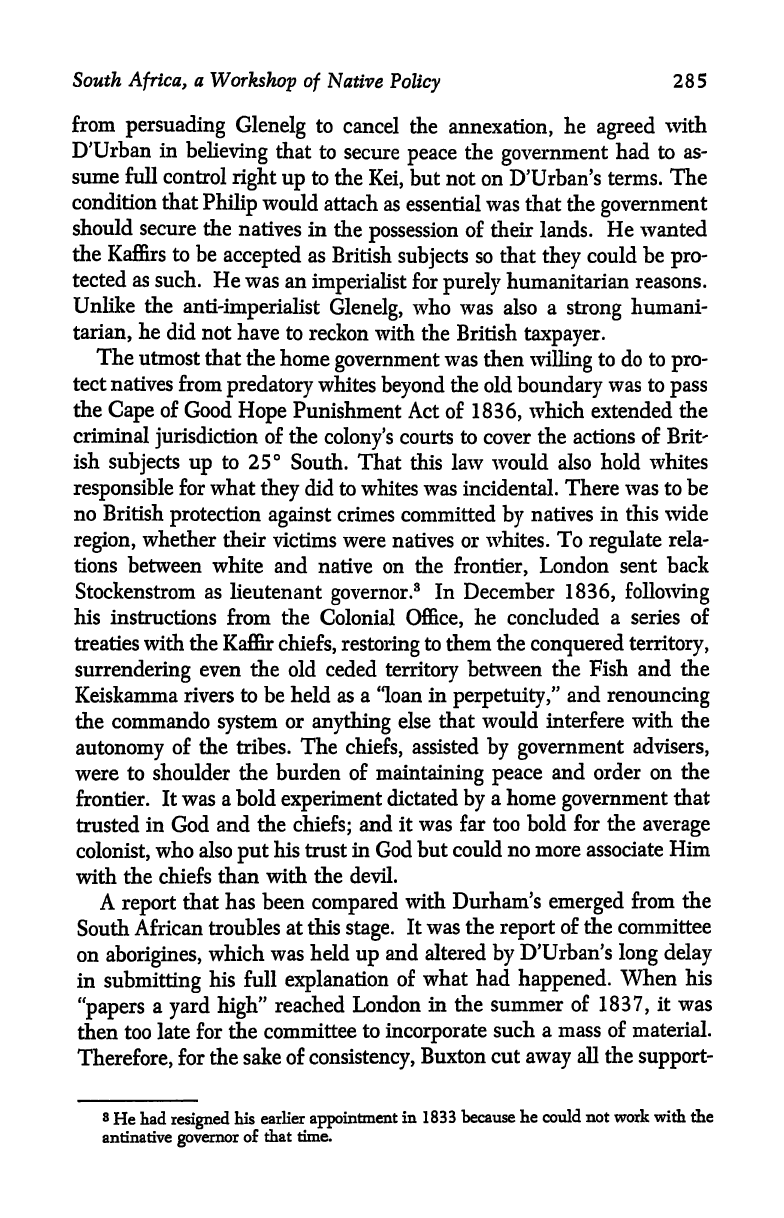
South
Africa,
a
Workshop
of
'Native
Policy
285
from
persuading
Glenelg
to
cancel the
annexation,
he
agreed
with
D'Urban
in
believing
that
to
secure
peace
the
government
had to
as-
sume
full
control
right
up
to the
Kei,
but not on D'Urban's
terms.
The
condition
that
Philip
would attach
as essential was that the
government
should secure the
natives
in
the
possession
of their
lands.
He wanted
the Kaffirs to be
accepted
as
British
subjects
so that
they
could be
pro-
tected as
such.
He
was
an
imperialist
for
purely
humanitarian
reasons.
Unlike the
anti-imperialist
Glenelg,
who was also
a
strong
humani-
tarian,
he
did
not have
to
reckon with
the
British
taxpayer.
The
utmost
that the
home
government
was then
willing
to
do
to
pro-
tect
natives
from
predatory
whites
beyond
the old
boundary
was
to
pass
the
Cape
of
Good
Hope
Punishment Act
of
1836,
which extended
the
criminal
jurisdiction
of the
colony's
courts to cover
the actions of
Brit'
ish
subjects
up
to
25
South.
That this law would
also hold
whites
responsible
for
what
they
did to whites was incidental.
There
was to be
no British
protection
against
crimes committed
by
natives
in this
wide
region,
whether
their
victims were
natives or
whites. To
regulate
rela-
tions between
white
and native on
the
frontier,
London sent
back
Stockenstrom
as
lieutenant
governor.
3
In
December
1836,
following
his
instructions from the
Colonial
Office,
he concluded
a
series
of
treaties with
the
Kaffir
chiefs,
restoring
to
them
the
conquered
territory,
surrendering
even
the
old ceded
territory
between the
Fish
and
the
Keiskamma rivers to be held as
a
"loan
in
perpetuity,"
and
renouncing
the
commando
system
or
anything
else
that
would
interfere with
the
autonomy
of the
tribes.
The
chiefs,
assisted
by
government
advisers,
were to
shoulder the burden of
maintaining peace
and
order on
the
frontier.
It was
a bold
experiment
dictated
by
a
home
government
that
trusted
in
God
and
the
chiefs;
and
it was far too bold
for the
average
colonist,
who also
put
his trust
in
God but
could no
more associate
Him
with
the chiefs
than with
the
devil.
A
report
that has been
compared
with Durham's
emerged
from the
South
African
troubles
at this
stage.
It was
the
report
of
the
committee
on
aborigines,
which
was
held
up
and
altered
by
D'Urban's
long
delay
in
submitting
his
full
explanation
of
what had
happened.
When
his
"papers
a
yard
high"
reached London
in the
summer
of
1837,
it was
then
too late
for
the committee
to
incorporate
such
a mass of material.
Therefore,
for
the sake of
consistency,
Buxton
cut
away
all
the
support-
8
He
had
resigned
his
earlier
appointment
in 1833
because
he could
not work with the
antinative
governor
of
that
time.
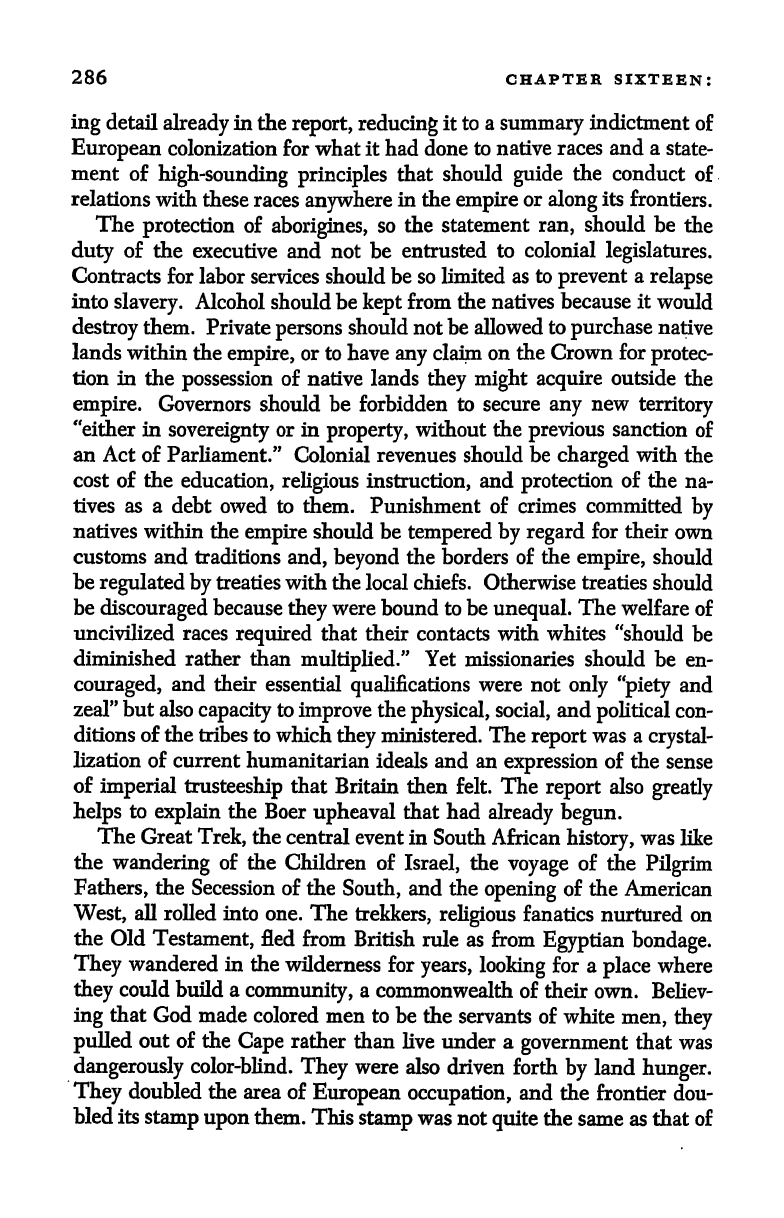
286
CHAPTER
SIXTEEN:
ing
detail
already
in the
report,
reducing
it
to a
summary
indictment
of
European
colonization
for what it had
done
to
native
races
and
a
state-
ment
of
high-sounding
principles
that
should
guide
the
conduct
of
relations with
these
races
anywhere
in the
empire
or
along
its
frontiers.
The
protection
of
aborigines,
so
the statement
ran,
should
be
the
duty
of
the executive
and not be
entrusted
to colonial
legislatures.
Contracts
for
labor
services
should
be so limited
as
to
prevent
a
relapse
into
slavery.
Alcohol
should be
kept
from
the natives
because it
would
destroy
them.
Private
persons
should
not
be allowed
to
purchase
native
lands
within the
empire,
or to have
any
claim on
the
Crown
for
protec-
tion in the
possession
of native lands
they
might
acquire
outside
the
empire.
Governors
should
be forbidden to secure
any
new
territory
"either in
sovereignty
or in
property,
without the
previous
sanction
of
an Act
of Parliament."
Colonial revenues should be
charged
with
the
cost
of
the
education,
religious
instruction,
and
protection
of
the
na-
tives as a
debt
owed to
them.
Punishment of crimes committed
by
natives within the
empire
should be
tempered by regard
for their
own
customs and
traditions
and,
beyond
the borders
of
die
empire,
should
be
regulated
by
treaties with the
local
chiefs. Otherwise
treaties
should
be
discouraged
because
they
were
bound to be
unequal.
The
welfare
of
uncivilized races
required
that their contacts with whites
"should
be
diminished rather than
multiplied."
Yet missionaries should
be
en-
couraged,
and
their essential
qualifications
were
not
only
"piety
and
zeal"
but
also
capacity
to
improve
the
physical,
social,
and
political
con-
ditions of the
tribes to
which
they
ministered. The
report
was a
crystal-
lization of current
humanitarian
ideals and an
expression
of
the
sense
of
imperial
trusteeship
that Britain then
felt. The
report
also
greatly
helps
to
explain
the Boer
upheaval
that
had
already
begun.
The
Great
Trek,
the
central
event in
South African
history,
was
like
the
wandering
of the
Children
of
Israel,
the
voyage
of
the
Pilgrim
Fathers,
the
Secession of the
South,
and the
opening
of
the
American
West,
all
rolled
into one. The
trekkers,
religious
fanatics
nurtured on
the
Old
Testament,
fled
from
British rule
as from
Egyptian
bondage.
They
wandered in the
wilderness
for
years,
looking
for a
place
where
they
could
build
a
community,
a
commonwealth
of their
own.
Believ-
ing
that
God
made
colored men to
be
the
servants of
white
men,
they
pulled
out of
the
Cape
rather
than
live
under
a
government
that was
dangerously
color-blind.
They
were
also driven forth
by
land
hunger.
They
doubled the area
of
European
occupation,
and the
frontier dou-
bled its
stamp upon
them.
This
stamp
was not
quite
the
same
as
that of
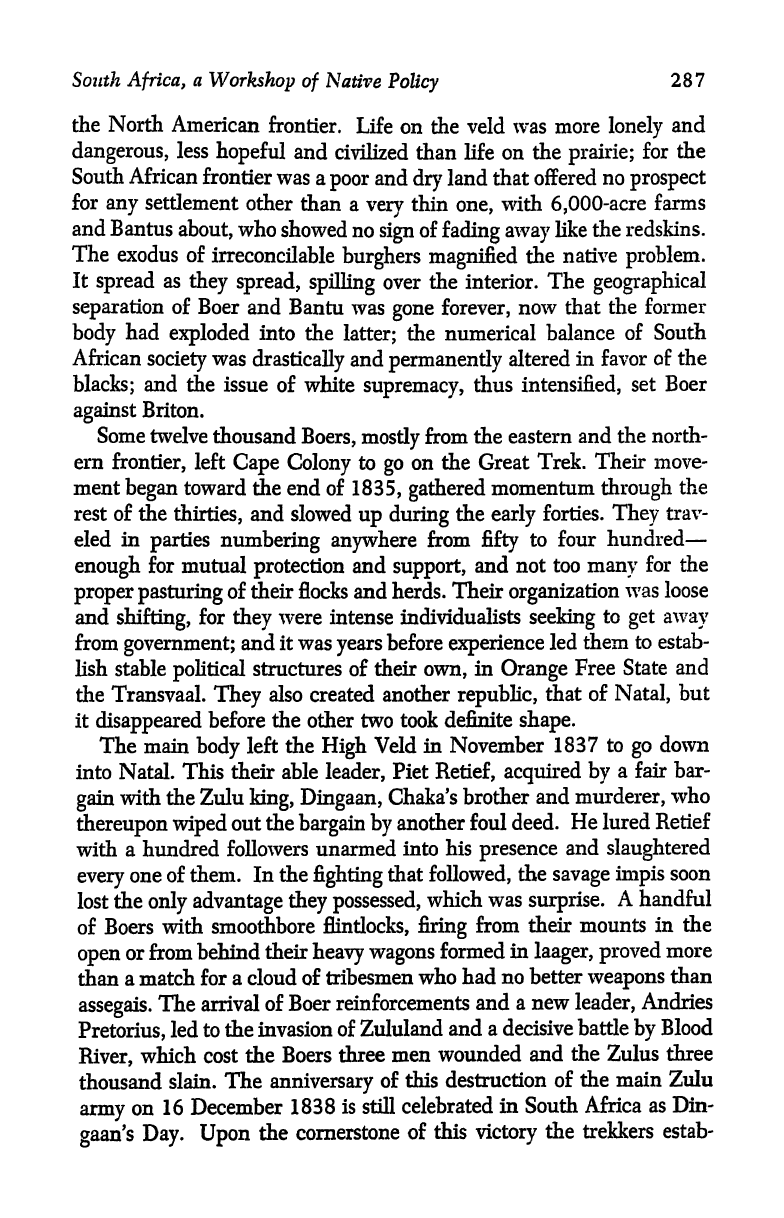
South
Africa,
a
Workshop
of
Native
Policy
287
the
North
American
frontier.
Life
on
the
veld
was more
lonely
and
dangerous,
less
hopeful
and
civilized
than
life
on
the
prairie;
for
the
South African
frontier
was
a
poor
and
dry
land
that
offered
no
prospect
for
any
settlement
other
than
a
very
thin
one,
with
6,000-acre
farms
and
Bantus
about,
who
showed
no
sign
of
fading
away
like
the
redskins.
The
exodus
of
irreconcilable
burghers magnified
the
native
problem.
It
spread
as
they
spread,
spilling
over
the
interior.
The
geographical
separation
of Boer
and Bantu
was
gone
forever,
now
that
the
former
body
had
exploded
into
the
latter;
the
numerical
balance
of South
African
society
was
drastically
and
permanently
altered
in favor
of the
blacks;
and
the issue
of white
supremacy,
thus
intensified,
set
Boer
against
Briton.
Some
twelve
thousand
Boers,
mostly
from
the
eastern
and the north-
ern
frontier,
left
Cape
Colony
to
go
on the Great
Trek.
Their move-
ment
began
toward
tie end of
1835,
gathered
momentum
through
the
rest of the
thirties,
and slowed
up
during
the
early
forties.
They
trav-
eled
in
parties
numbering
anywhere
from
fifty
to
four
hundred
enough
for
mutual
protection
and
support,
and not
too
many
for the
proper
pasturing
of their
flocks and herds.
Their
organization
was loose
and
shifting,
for
they
were intense
individualists
seeking
to
get
away
from
government;
and it
was
years
before
experience
led
them
to estab-
lish stable
political
structures of
their
own,
in
Orange
Free
State
and
the Transvaal.
They
also
created
another
republic,
that of
Natal,
but
it
disappeared
before
the other
two
took
definite
shape.
The main
body
left
the
High
Veld
in November
1837
to
go
down
into
Natal.
This
their
able
leader,
Piet
Retief,
acquired
by
a fair bar-
gain
with the Zulu
king,
Dingaan,
Chaka's
brother
and
murderer,
who
thereupon
wiped
out the
bargain
by
another
foul
deed.
He lured
Retief
with a hundred
followers
unarmed
into
his
presence
and
slaughtered
every
one
of
them.
In
the
fighting
that
followed,
the
savage
impis
soon
lost
the
only
advantage they
possessed,
which
was
surprise.
A handful
of
Boers
with smoothbore
flintlocks,
firing
from
their mounts
in
the
open
or
from
behind
their
heavy wagons
formed
in
laager,
proved
more
than
a match
for
a
cloud
of
tribesmen
who
had no better
weapons
than
assegais.
The
arrival
of Boer
reinforcements
and
a new
leader,
Andries
Pretorius,
led
to
the invasion
of
Zululand
and
a decisive
battle
by
Blood
River,
which
cost
the
Boers
three
men
wounded
and
the Zulus
three
thousand
slain.
The
anniversary
of this
destruction
of
the main
Zulu
army
on
16
December
1838
is still
celebrated
in
South
Africa
as
Din-
gaan's
Day. Upon
the
cornerstone
of
this
victory
the
trekkers estab-

288 CHAPTER
SIXTEEN:
lished
their
ephemeral
republic
and
its
lasting
capital,
Pietermaritz-
burg,
in
1839;
and with
poetic
justice
Pretorius
helped
to
remove
Dingaan
in
1840
by
supporting
his brother
Panda,
who
then
became
a
vassal
king
paying
a
heavy
tribute
to
the Boers.
British
intervention cut short
the
life
of the Natal
republic.
Unable
to
prevent
the
Great
Trek,
which violated
the
policy
inherited
from
the
Dutch,
British
authority
could
not
at
first make
up
its mind
whether
to
follow
the
emigrants
or
leave
them alone.
When
the
trekkers
de-
scended from the
Drakensberg
Mountains,
British
ivory
traders,
by
agreement
with
the
Zulu
king,
had
been
in
Port Natal
for more
than
a
dozen
years
and
they
had
just
received a
magistrate
under
the
act
of
1836.
Stirred
by
the
massacre
perpetrated
by
Dingaan,
they
tried
to
aid
the
Boers,
with
the
result
that
they
suffered
defeat and
lost
their
base. Sir
George
Napier,
D'Urban's
successor,
was anxious
to
throw
a
military contingent
into
Port
Natal,
not to recover
it
for
these
people,
but
to
use
it as a check
upon
the
emigrant
Boers who were
stirring
up
a
hornets'
nest and
endangering
the British
frontier.
The home
govern-
ment,
on the
other
hand,
favored
curtailing
rather than
expanding
its
commitments
in
South
Africa,
as
elsewhere;
and there
was
quite
an
argument
between
London and
Cape
Town. In 1839
Napier
dis-
patched
a
contingent
too small
and too late to control
the
situation,
and
he
withdrew
it at the
end
of
the
year.
It
was
the
native
policy
of
the
Natalians
that
decided the
issue.
They
attacked
the natives
to
the
southwest,
back toward the Kaffir
frontier
of
the
colony;
their un-
checked
pass
law
and
apprenticeship
system
was
reducing
to
slavery
the blacks
whom
they
employed.
The second and final British
occupation
of
Port Natal
began
in
May
1842,
the
troops
having
been
ordered
up by
the
governor
to
give
secu-
rity
to
the
Cape
frontier. This
time
the Boers
attacked
the
British
and
were
compelled
to
disperse only
when the
latter were
reinforced. In-
stead of
concurring
in the
occupation,
the
Colonial Office ordered
a
withdrawal and
proposed
to
control
the
trekkers
by
prohibiting
inter-
course
with them.
Napier
then
won
the
argument by
pointing
out that
such
a
prohibition
would be
impolitic
and
impossible,
and
that the
recall
of the
troops
would be
abandoning
Natal to the
Boer
invaders
and
its
natives to
slavery.
In the
following spring
the
governor
formally
proclaimed
the annexation
of
Natal,
and
sent
Henry
Cloete,
a
lawyer
of
Cape
Town,
a
son of one
of
the
oldest
Cape
Dutch
families,
and
a mem-
ber of
the new
legislative
council,
to
negotiate
a settlement
with the trek-
kers
in
the
new
possession.
On condition
that
there
be no
slavery,
no
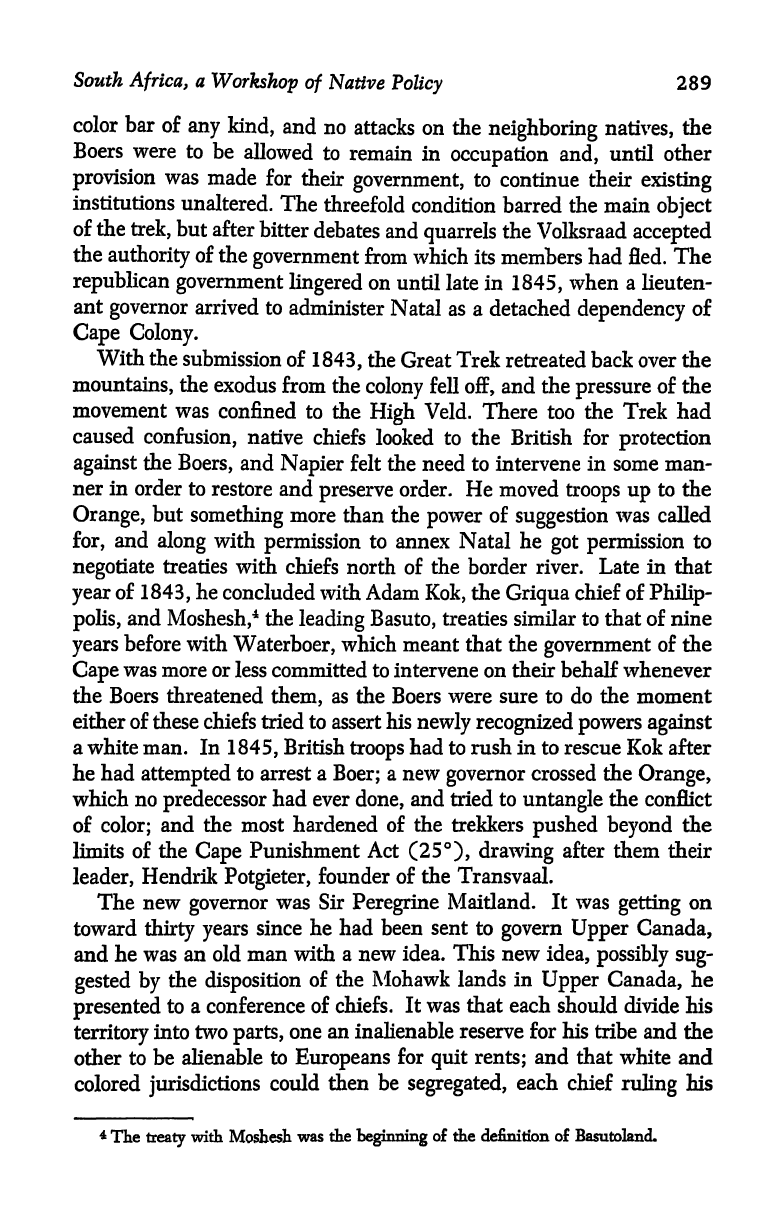
South
Africa,
a
Workshop
of
Native
Policy
289
color
bar
of
any
kind,
and no
attacks
on
the
neighboring
natives,
the
Boers were
to be
allowed
to
remain
in
occupation
and,
until
other
provision
was
made
for
their
government,
to
continue
their
existing
institutions
unaltered.
The
threefold
condition barred the main
object
of the
trek,
but after
bitter
debates
and
quarrels
the
Volksraad
accepted
the
authority
of
the
government
from
which its
members
had fled.
The
republican
government
lingered
on
until late
in
1845,
when a lieuten-
ant
governor
arrived to
administer
Natal as
a detached
dependency
of
Cape
Colony.
With
the
submission
of
1843,
the
Great
Trek retreated back
over the
mountains,
the
exodus
from the
colony
fell
off,
and the
pressure
of the
movement
was
confined
to the
High
Veld. There too
the
Trek
had
caused
confusion,
native
chiefs
looked
to the
British for
protection
against
the
Boers,
and
Napier
felt the
need
to intervene
in some man-
ner in
order to
restore
and
preserve
order.
He moved
troops up
to the
Orange,
but
something
more
than the
power
of
suggestion
was
called
for,
and
along
with
permission
to annex Natal he
got
permission
to
negotiate
treaties
with
chiefs
north of
the
border river.
Late
in that
year
of
1843,
he
concluded
with
Adam
Kok,
the
Griqua
chief of
Philip-
polis,
and
Moshesh,
4
the
leading
Basuto,
treaties similar to that of nine
years
before with
Waterboer,
which meant
that
the
government
of
the
Cape
was
more
or
less committed to intervene
on
their behalf
whenever
the
Boers
threatened
them,
as the
Boers
were sure to
do
the
moment
either of
these chiefs tried to assert his
newly
recognized
powers against
a
white man. In
1845,
British
troops
had to
rush in to rescue Kok
after
he
had
attempted
to arrest
a
Boer;
a
new
governor
crossed
the
Orange,
which no
predecessor
had
ever
done,
and
tried to
untangle
the
conflict
of
color;
and the most hardened
of the trekkers
pushed beyond
the
limits
of the
Cape
Punishment
Act
(25),
drawing
after them
their
leader,
Hendrik
Potgieter,
founder
of the Transvaal.
The
new
governor
was
Sir
Peregrine
Maitland. It
was
getting
on
toward
thirty years
since he had been
sent
to
govern Upper
Canada,
and
he was
an
old
man
with
a new idea. This new
idea,
possibly
sug-
gested
by
the
disposition
of the
Mohawk lands
in
Upper
Canada,
he
presented
to
a conference
of chiefs.
It was that
each
should
divide his
territory
into
two
parts,
one
an
inalienable
reserve
for his
tribe
and the
other
to
be alienable
to
Europeans
for
quit
rents;
and that
white
and
colored
jurisdictions
could
then be
segregated,
each
chief
ruling
his
4
The
treaty
with
Moshesh
was
the
beginning
of the definition of
Basutoland.

290
CHAPTER
SIXTEEN:
own
people
on their
reserve,
and
a
British
resident
managing
the
Europeans
on the
lands
they
leased.
Accordingly
Adam
Kok
parti-
tioned his
principality,
and
a
British
resident
was established
at
Bloem-
fontein
in the
alienable
part
of
Philippolis.
If
Maidand's
refined
version
of an
old theme
the
white man's
appropriation
of the
colored
man's
scanty
lands had
any
chance
of
adoption
elsewhere,
it
was
spoiled
by
the outbreak
of another
Kaffir
war,
which
required
the
substitution
of a
younger
soldier
as
governor.
The
Kaffir
war that
began
early
in 1846 is
known
by
a
name,
not
a
number
the
War
of
the
Ax. An
old
Kaffir
thief,
accused
of
stealing
an
ax,
was
being brought
to Grahamstown
for
trial
when some
natives
from across
the
border
forcibly
rescued him.
Thereupon
colonial
troops
invaded
Kaffirland,
and
the war
was
on. Another
incident
might
just
as well
have
started
it,
for the chronic trouble
of
the eastern
frontier
was
again
coming
to a
head
in one of its
periodic
climaxes.
The
settle-
ment
negotiated
by
Stockenstrom late
in
1836
had broken
down,
as
was
inevitable.
The Kaffirs
were
savages
and too numerous
for
the
land
on
which
they
lived;
5
and
the
effective
policing
of
the
border,
across
which
there
was
considerable
coming
and
going
for
peaceful
purposes,
was
impossible
because
the
colony
could
not
pay
for
it
and
the
mother
country
would
not.
In
1840
Napier reported
the
mounting
tension
arising
from the constant
plunder
of farmers' cattle
and
the
not
infre-
quent
murder of their armed
herdsmen. To avoid
the
danger
of
war
precipitated
by
outraged
farmers'
taking
the law
into
their own
hands
and
crossing
the
border
in
commandos,
he
persuaded
the Kaffir
chiefs
to
accept
a
modification
of
the
Stockenstrom treaties. Maitland went
further
in
the
same
direction
and
for
the
same
reason,
with
the
result
that
the
1836
system
gradually
disappeared
and
the
extension
of white
power
into
Kaffirland,
intended
to
prevent
hostilities,
tended to
provoke
them.
The
War
of
the
Ax was much like the "sixth" war
of a dozen
years
before,
except
that
it cost
more,
was
waged
on a wider
scale,
and
lasted
longer
almost to the end
of
1847,
nearly
two
years
in all.
This
war faced Lord
Grey
when he
took
charge
of the
Colonial
Office,
and
it
taught
him the
necessity
for a new frontier
policy
in
South
Africa.
Though agreeing
with
his
predecessors
that
territorial
acquisi-
tions
in this
quarter,
considered
by
themselves,
"would
not
be
merely
worthless,
but
pernicious
the
source
not of
increased
strength
but
of
weakness,"
he
was
nevertheless
prepared
to
accept
annexation
as the
B
By.
1843
many
Kaffirs
were
destitute
of
cattle.
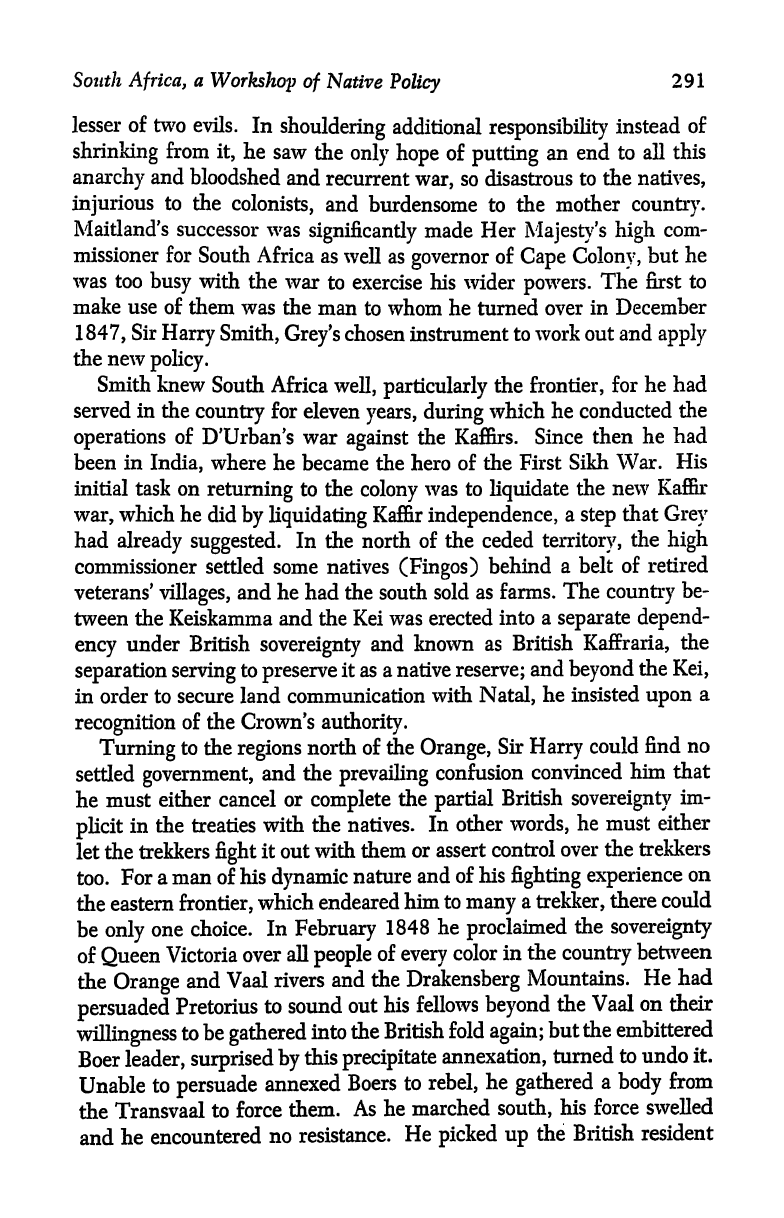
South
Africa,
a
Workshop of
Native
Policy
291
lesser
of
two evils.
In
shouldering
additional
responsibility
instead
of
shrinking
from
it,
he
saw
the
only
hope
of
putting
an
end to
all
this
anarchy
and
bloodshed
and
recurrent
war,
so disastrous
to
the
natives,
injurious
to the
colonists,
and
burdensome to
the
mother
country.
Maitland's
successor
was
significantly
made
Her
Majesty's
high
com-
missioner
for
South
Africa
as
well as
governor
of
Cape
Colony,
but
he
was too
busy
with the
war
to exercise his wider
powers.
The
first to
make use
of them
was the
man
to
whom
he turned over
in December
1847,
Sir
Harry
Smith,
Grey's
chosen instrument
to work out
and
apply
the
new
policy.
Smith knew
South
Africa
well,
particularly
the
frontier,
for
he had
served in
the
country
for
eleven
years,
during
which
he conducted
the
operations
of
D'Urban's
war
against
the
Kaffirs.
Since
then
he had
been
in
India,
where he
became
the hero
of the First
Sikh
War.
His
initial task on
returning
to the
colony
was to
liquidate
the
new
Kaffir
war,
which he
did
by
liquidating
Kaffir
independence,
a
step
that
Grey
had
already
suggested.
In the north
of the ceded
territory,
the
high
commissioner
settled
some natives
(Fingos)
behind
a belt
of
retired
veterans'
villages,
and he
had
the south sold
as
farms.
The
country
be-
tween
the Keiskamma
and
the Kei
was erected
into
a
separate
depend-
ency
under
British
sovereignty
and
known as
British
Kaffraria,
the
separation serving
to
preserve
it as a
native
reserve;
and
beyond
the
Kei,
in
order
to
secure
land
communication
with
Natal,
he insisted
upon
a
recognition
of the Crown's
authority.
Turning
to
the
regions
north
of the
Orange,
Sir
Harry
could
find
no
settled
government,
and
the
prevailing
confusion
convinced
him that
he
must
either
cancel or
complete
the
partial
British
sovereignty
im-
plicit
in
the
treaties
with the natives.
In
other
words,
he must
either
let
the trekkers
fight
it out
with them
or
assert
control
over the
trekkers
too.
For
a
man of his
dynamic
nature
and of
his
fighting
experience
on
the
eastern
frontier,
which
endeared
him
to
many
a
trekker,
there could
be
only
one
choice.
In
February
1848
he
proclaimed
the
sovereignty
of
Queen
Victoria
over
all
people
of
every
color
in
the
country
between
the
Orange
and
Vaal
rivers
and the
Drakensberg
Mountains.
He
had
persuaded
Pretorius
to
sound
out
his
fellows
beyond
the Vaal
on
their
willingness
to
be
gathered
into
the
British
fold
again;
but
the
embittered
Boer
leader,
surprised
by
this
precipitate
annexation,
turned
to undo
it.
Unable
to
persuade
annexed
Boers
to
rebel,
he
gathered
a
body
from
the
Transvaal
to
force
them.
As he
marched
south,
his force
swelled
and
he
encountered
no
resistance.
He
picked
up
the British
resident
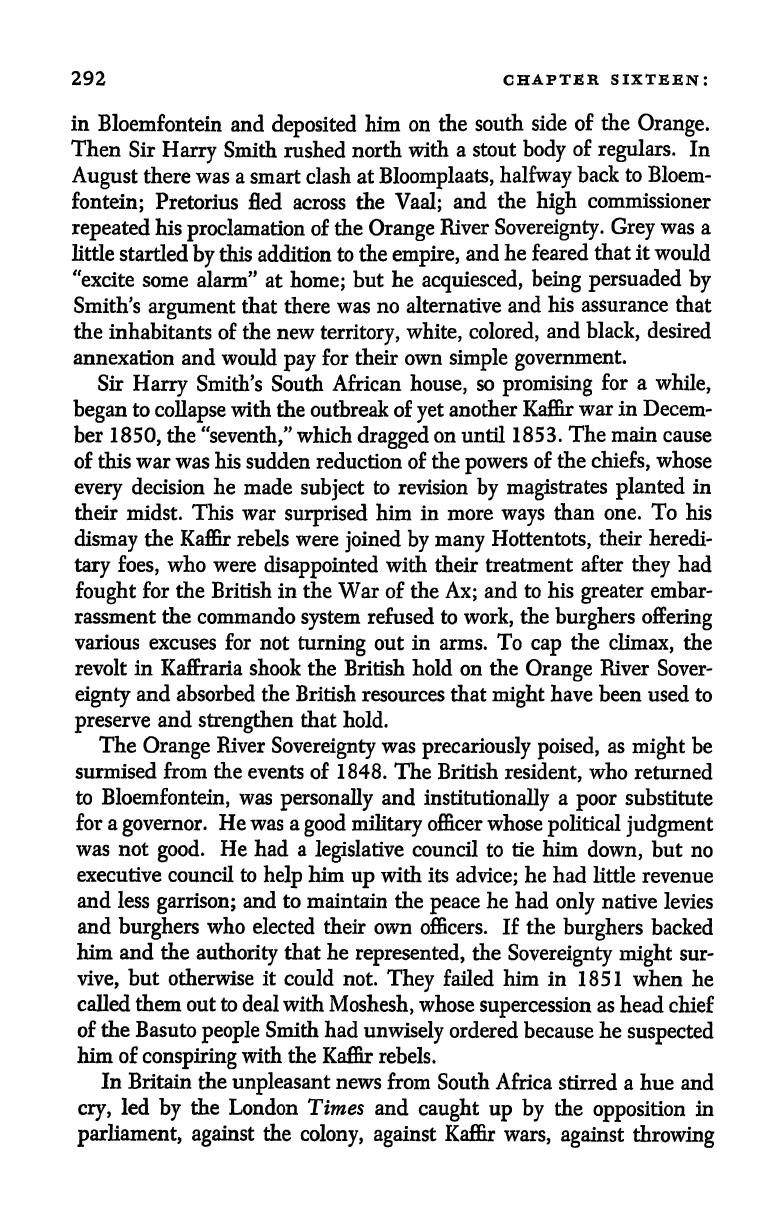
292 CHAPTER
SIXTEEN:
in
Bloemfontein and
deposited
him on
the
south
side of
the
Orange.
Then
Sir
Harry
Smith
rushed
north
with
a stout
body
of
regulars.
In
August
there
was
a
smart clash
at
Bloomplaats,
halfway
back
to
Bloem-
fontein;
Pretorius
fled across
the
Vaal;
and
the
high
commissioner
repeated
his
proclamation
of the
Orange
River
Sovereignty.
Grey
was
a
little
startled
by
this
addition
to the
empire,
and
he
feared
that
it
would
"excite
some
alarm"
at
home;
but he
acquiesced,
being
persuaded
by
Smith's
argument
that there
was
no alternative
and
his
assurance that
the
inhabitants of the new
territory,
white,
colored,
and
black,
desired
annexation
and would
pay
for
their
own
simple government.
Sir
Harry
Smith's South
African
house,
so
promising
for
a
while,
began
to
collapse
with
the outbreak of
yet
another
Kaffir
war in
Decem-
ber
1850,
the
"seventh,"
which
dragged
on
until
1853.
The main
cause
of
this war was
his sudden reduction
of the
powers
of the
chiefs,
whose
every
decision he
made
subject
to revision
by
magistrates
planted
in
their
midst. This war
surprised
him
in more
ways
than
one.
To
his
dismay
the
Kaffir
rebels were
joined
by
many
Hottentots,
their
heredi-
tary
foes,
who were
disappointed
with their
treatment
after
they
had
fought
for the
British
in the
War
of
the
Ax;
and
to
his
greater
embar-
rassment
the
commando
system
refused
to
work,
the
burghers
offering
various
excuses for
not
turning
out in arms. To
cap
the
climax,
the
revolt
in Kaffraria
shook the
British
hold on
the
Orange
River
Sover-
eignty
and
absorbed
the
British resources that
might
have been
used to
preserve
and
strengthen
that hold.
The
Orange
River
Sovereignty
was
precariously
poised,
as
might
be
surmised
from the
events of
1848.
The British
resident,
who
returned
to
Bloemfontein,
was
personally
and
institutionally
a
poor
substitute
for a
governor.
He
was
a
good military
officer
whose
political
judgment
was not
good.
He had
a
legislative
council
to
tie
him
down,
but
no
executive
council to
help
him
up
with its
advice;
he
had little revenue
and less
garrison;
and
to maintain
the
peace
he
had
only
native
levies
and
burghers
who
elected their own
officers. If the
burghers
backed
him
and
the
authority
that he
represented,
the
Sovereignty might
sur-
vive,
but otherwise it
could
not.
They
failed
him in
1851
when he
called
them out
to
deal
with
Moshesh,
whose
supercession
as
head chief
of
the
Basuto
people
Smith
had
unwisely
ordered
because
he
suspected
him of
conspiring
with
the Kaffir
rebels.
In
Britain
the
unpleasant
news from
South Africa
stirred
a
hue and
cry,
led
by
the
London Times
and
caught up
by
the
opposition
in
parliament, against
the
colony,
against
Kaffir
wars,
against
throwing

South
Africa,
a
Workshop
of
Native
Policy
293
away
millions on
both,
against
the
Colonial
Office,
and
against
the
government.
Grey
sent Smith
more
troops
with which to
extricate
him-
self
from his
difficulties
on
the north as well
as the
east,
but
he sent
them
very
grudgingly
and
with
a
warning
that
it
might
be
necessary
to
withdraw
from
beyond
the
Orange.
If
the
inhabitants
would
not
sup-
port
British
authority
there,
"but on the
contrary
desire
to be
relieved
from
it,
there
is
no
British
interest
to
be
served
by
endeavouring
to
maintain it."
He
admitted that
"the check which
would
be
given
to
the
progress
of
civilization,
and the
anarchy
and bloodshed
which
would
too
probably
follow
.
.
.
would no doubt be
greatly
to be
lamented,"
but
this
could not be
helped
because
the British
people
would not
pay,
and
could
not
be
expected
to
pay,
for the
imposition
of
the alternative.
As
a further
warning
of a
change
in
policy,
the colonial
secretary appointed
two
assistant
commissioners
"for
the
settling
and
adjusting
of
the
affairs of the eastern
and
northern
boundaries"
without
having
to
report
through
the
high
commissioner.
Sir
Harry
was
eager
to
save
the
Sovereignty
as
the
keystone
of
the
whole South African
structure,
lying
as
it did
between
the
Cape,
Natal,
and
the Transvaal. So he
rushed
the
assistant
commissioners
north,
hoping
that
they
would
preserve
his
work
by completing
it with the
addition
of
the
Transvaal,
which had
yet
to
achieve
political
unity
and
stability.
But
Smith
was
praying
for the
impossible.
The Boers
of the
Transvaal
were
the most
irreconcilable
of all
Boers,
and
the most
re-
motebetween
750 and
1000 miles
from
Cape
Town.
Their
inde-
pendence
could
not
be
denied;
and unless
the British
would
recognize
it,
Pretorius
threatened
to overturn
the
Sovereignty
again.
The
upshot
was
the Sand
River Convention
of
January
1852,
which
recognized
the
independence
of
the
Transvaal,
banned
slavery
in
it,
prohibited
British
alliances
with
"coloured
nations"
in
it,
provided
for
mutual
extradition
of
criminals
and facilities
for
trade,
guaranteed
to
the
Transvaalers
the
freedom
to
purchase
ammunition
from the
British,
and outlawed
the
sale
of
it
to
natives
on either
side
of
the
Vaal.
The
imperial
tide
that
began
to ebb
at
the
Vaal
was
soon back
to the
Orange.
Grey
was
prepared
for
this
retreat
before
he left
office
early
in
1852;
and
his
successors,
Tory
and
Whig,
were
likewise
resigned
to
the
surrender
of the
Sovereignty
because
it did not
seem
worth what
it
would
cost
to
keep
it.
By
the
Bloemfontein
Convention
of
February
1854,
it was
turned
over
to
its
burgher
leaders
on terms
that
were
an
expansion
of
those
of
the
Sand
River Convention.
As the United
States
was
then
split
over
the colored
population,
so
was South
Africa,
only

294
CHAPTER
SIXTEEN:
more
deeply.
It
was
as
if
the American North lacked the
strength
of
body
and of
will to
challenge
the
secession
of
the
South. The
two
halves
of
South
Africa,
now
quite
independent
of
each
other,
were
to
pursue
radically
different
policies
that would
make
their common
and
greatest
problem
still
more
difficult.
Meanwhile in
Cape
Colony
the
conflict
between the
two basic
prin-
ciples
of
colonial
self-government
and
imperial trusteeship
was
being
resolved
in
favor
of the
former
though
not
wholly
so.
When
Durham
wrote
in
his
report
that French Canada
had
been
introduced
to
self-
government
at
the
wrong
end,
at
the
top
instead
of the
bottom,
self-
government
at the
Cape
was
beginning
to
grow
from below
as it
had
done
centuries
before in
England.
The
legislative
council
planted
the
seed
in
an
ordinance
of 1836 that
authorized as few as
twenty-five
householders who
formed
a
village
to
initiate an
elected
municipal
government,
and
by
1840
there was a
healthy
crop
of
such
institutions.
Three
years
later
two other
ordinances
furthered the cause
of
self-
government
in the
colony.
One
provided
for
local roads
under
the
direction of
elected
road
boards. The
other
conferred
a
large
measure
of
autonomy upon
the
church
of
the
great
majority,
the
Dutch
Re-
formed
Church,
which
had been
more
or less
under the
thumb of
the
administration.
Petitions
for an
assembly
were
again
sent
to London
in
1841,
this
time
backed
by
the
governor
and
citing
the
success of
municipal
self-
government
as
justification.
Stanley,
the
colonial
secretary,
replied
in
the
following
year,
accepting
the
general principle
but
raising
all
man-
ner
of
practical
objections
to
its
application
at
the
Cape,
particularly
the
cleavage
between the white
and die
colored
populations.
But the
im-
provement
of relations
between them
undermined
Stanley's
argument.
This same
year
saw the
passage
of the
Master
and Servants
Ordinance,
which
scrupulously
avoided
any
reference to color
and
rendered
the
Fiftieth
Ordinance obsolete.
The
old
hostility
between
the
mission
stations and the
colonists,
caused
by
the
racial
issue,
was
dying
down.
Colored
people qualified
for the
municipal
franchise
and
exercised
it;
and one of them
was
elected in
Cape
Town
with
such
little
fuss
that
the
colonial
secretary
of
the
Cape
did not hear
about his
election
and
withdrawal until some
time
afterward and then
by
mere
accident.
In
1846
the
House of
Commons called for a
return of
all
applica-
tions from the
Cape
for
representative
government
and of
the
answers
thereto;
and
Grey
sent the
printed
report
to the
governor,
a new
one,
asking
him if the
principle
might
not be
applied.
The
War
of the
Ax
